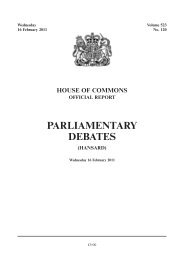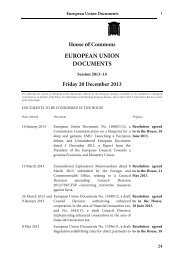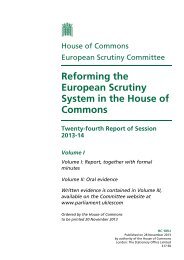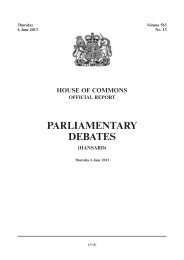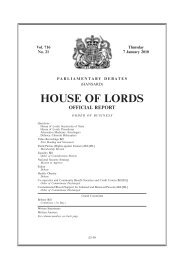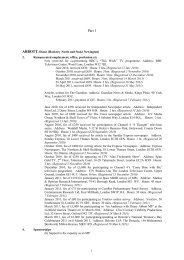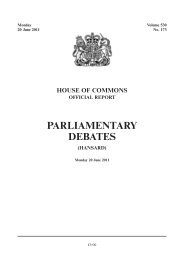Ticketing and Concessionary Travel on Public Transport - United ...
Ticketing and Concessionary Travel on Public Transport - United ...
Ticketing and Concessionary Travel on Public Transport - United ...
Create successful ePaper yourself
Turn your PDF publications into a flip-book with our unique Google optimized e-Paper software.
Ev 160 <strong>Transport</strong> Committee: Evidence<br />
introducti<strong>on</strong> of Oyster). In additi<strong>on</strong>, at certain highly-c<strong>on</strong>gested Underground stati<strong>on</strong>s such as Bank, the<br />
reducti<strong>on</strong> in c<strong>on</strong>gesti<strong>on</strong> achieved with Oyster has meant that passenger volume growth has been<br />
accommodated without the need for sizable capital investment in exp<str<strong>on</strong>g>and</str<strong>on</strong>g>ing ticket halls. Oyster has also<br />
delivered real financial benefits by preventing <str<strong>on</strong>g>and</str<strong>on</strong>g> eliminating several types of fraud, such as the re-sale of<br />
discarded <strong>on</strong>e-day tickets by touts which so blighted the envir<strong>on</strong>ment of so many Underground stati<strong>on</strong>s in<br />
the 1990s <str<strong>on</strong>g>and</str<strong>on</strong>g> also the use of forged paper tickets. Other operators elsewhere in the UK may well be able to<br />
replicate the benefits from fraud reducti<strong>on</strong>, but the n<strong>on</strong>-financial passenger benefits <str<strong>on</strong>g>and</str<strong>on</strong>g> capital investment<br />
avoidance benefits may be harder to replicate except for operators in those urban centres where peak<br />
passenger flows result in queuing <str<strong>on</strong>g>and</str<strong>on</strong>g> over-crowding at levels similar to L<strong>on</strong>d<strong>on</strong>.<br />
3.3 The sec<strong>on</strong>d main less<strong>on</strong> has been that smartcards can be the foundati<strong>on</strong> for the transformati<strong>on</strong> of<br />
transport operators’ relati<strong>on</strong>ships with their customers. More than 1m Oyster card users have chosen to<br />
register their card details with TfL <str<strong>on</strong>g>and</str<strong>on</strong>g> c<strong>on</strong>stantly re-use a single registered Oyster card for their travel.<br />
Where the necessary customer c<strong>on</strong>sent has been given, TfL can proactively warn these customers by email<br />
or text message several days beforeh<str<strong>on</strong>g>and</str<strong>on</strong>g> that the service that they normally use will not be available <str<strong>on</strong>g>and</str<strong>on</strong>g><br />
suggest alternatives. Another benefit is the free replacement of products if a card is lost: where a customer<br />
has registered a card number with TfL, its number can be “hot-listed” if lost so that the card cannot be reused<br />
<strong>on</strong> the system. A new card with duplicate products is issued to the customer.<br />
3.4 The final less<strong>on</strong> c<strong>on</strong>cerns the implementati<strong>on</strong> challenge of a smartcard ticketing scheme. Oyster is a<br />
huge, complex system. To put it into c<strong>on</strong>text, where MasterCard processes about 40m payments every day<br />
worldwide, the Oyster system processes more than 10 milli<strong>on</strong> individual “taps” each day—it is at a<br />
comparable scale. Building, testing <str<strong>on</strong>g>and</str<strong>on</strong>g> commissi<strong>on</strong>ing such a system is detailed, dem<str<strong>on</strong>g>and</str<strong>on</strong>g>ing work <str<strong>on</strong>g>and</str<strong>on</strong>g> must<br />
be tackled in a step-by-step fashi<strong>on</strong> with each incremental development to the scheme released <strong>on</strong>e at a time<br />
after thorough testing <str<strong>on</strong>g>and</str<strong>on</strong>g> assurance. This is not just a c<strong>on</strong>sequence of the project complexity: account also<br />
needs to be taken of the pace at which customers can assimilate changes to the ticketing system. Smartcards<br />
change the fundamentals of ticketing systems <str<strong>on</strong>g>and</str<strong>on</strong>g> time must be allowed for customers to digest these changes<br />
<str<strong>on</strong>g>and</str<strong>on</strong>g> adapt to them.<br />
3.5 It rather misrepresents the situati<strong>on</strong> to refer in the Committee’s terms of reference for this inquiry to<br />
“the ITSO system”. There is no single ITSO system. There is a technical specificati<strong>on</strong>, a number of suppliers<br />
of equipment that comply with this specificati<strong>on</strong>, <str<strong>on</strong>g>and</str<strong>on</strong>g> a number of distinct smartcard schemes that use this<br />
equipment. It is not entirely clear that this set of entities makes up a system in the fullest sense of the word.<br />
3.6 Because the PFI c<strong>on</strong>tract for the Oyster system was made in 1998, it pre-dates the establishment of<br />
the Integrated <strong>Transport</strong> Smartcard Organisati<strong>on</strong> (ITSO) <str<strong>on</strong>g>and</str<strong>on</strong>g> the publicati<strong>on</strong> of the various parts of the<br />
ITSO specificati<strong>on</strong>. As a c<strong>on</strong>sequence, TfL has never formally analysed the ITSO specificati<strong>on</strong> nor<br />
compared it against Oyster. At no stage in the first nine years of the PFI c<strong>on</strong>tract could the benefits of ITSO<br />
c<strong>on</strong>ceivably have oVset the financial penalties of terminating the c<strong>on</strong>tract early.<br />
3.7 At the DfT’s request, an exercise is underway in which the PFI c<strong>on</strong>tractor is assessing what would be<br />
required to transform the Oyster smartcard system so that the various smartcard readers within it could also<br />
read <str<strong>on</strong>g>and</str<strong>on</strong>g> write to cards compliant with the ITSO specificati<strong>on</strong>. TfL believes that investment in such an<br />
upgrade project would be rather wasteful. The vast majority of TfL’s customers are residents or regular<br />
commuters who already have an Oyster card. Visitors can get <strong>on</strong>e from TfL in pers<strong>on</strong> or by post at any<br />
address in the UK or through Visit Britain’s arrangements overseas. The beneficiaries of such an investment<br />
programme would be people travelling to or through L<strong>on</strong>d<strong>on</strong> <strong>on</strong> an ITSO-compliant smartcard carrying<br />
travel products valid within L<strong>on</strong>d<strong>on</strong> but purchased outside L<strong>on</strong>d<strong>on</strong>. At present, there is no transport<br />
smartcard scheme in the UK that has these characteristics (although South West Trains has obligati<strong>on</strong>s to<br />
provide such a system from 2009). It is not clear what problem is to be solved through the investment of<br />
tens of milli<strong>on</strong>s of pounds in an upgrade that will benefit a small number of travellers who already have<br />
straightforward access to the benefits of smartcard ticketing in L<strong>on</strong>d<strong>on</strong> with Oyster.<br />
3.8 This is proving to be a fertile period in the history of the smartcard technology industry. The past 12<br />
m<strong>on</strong>ths have seen a noticeable accelerati<strong>on</strong> of technology trends in the industry that make assumpti<strong>on</strong>s<br />
made even as recently as 2004 seem dated. Prior to that date, the requirements of the public transportati<strong>on</strong><br />
industry were too dem<str<strong>on</strong>g>and</str<strong>on</strong>g>ing for the mainstream smartcard industry to meet. That industry focused <strong>on</strong><br />
providing smartcards to the banking payments <str<strong>on</strong>g>and</str<strong>on</strong>g> mobile ph<strong>on</strong>e industries in the form of very secure<br />
cryptographic products for c<strong>on</strong>sumers using c<strong>on</strong>tact interfaces—the Chip & PIN cards in peoples’ wallets<br />
or purses <str<strong>on</strong>g>and</str<strong>on</strong>g> the SIM card in their mobile ph<strong>on</strong>e h<str<strong>on</strong>g>and</str<strong>on</strong>g>sets. The dem<str<strong>on</strong>g>and</str<strong>on</strong>g>s of the public transportati<strong>on</strong><br />
industry were very diVerent. The very fast transacti<strong>on</strong> speeds that they dem<str<strong>on</strong>g>and</str<strong>on</strong>g>ed to achieve high passenger<br />
throughputs made the use of c<strong>on</strong>tact smartcards infeasible, so the main producers ignored the transport submarket<br />
<str<strong>on</strong>g>and</str<strong>on</strong>g> allowed a set of niche transport smartcard providers to appear. These providers thrived to<br />
varying degrees <str<strong>on</strong>g>and</str<strong>on</strong>g> their successes prompted some further entrants to compete, such as ITSO. For transport<br />
operators the market seemed relatively under-served <str<strong>on</strong>g>and</str<strong>on</strong>g> competiti<strong>on</strong> was diYcult to create.<br />
3.9 That situati<strong>on</strong> has recently changed dramatically. Some banks, notably in the <strong>United</strong> States, have<br />
decided to oVer c<strong>on</strong>tactless payment functi<strong>on</strong>ality <strong>on</strong> their bank cards in the hope that in certain c<strong>on</strong>texts<br />
customers will prefer to make a “tap <str<strong>on</strong>g>and</str<strong>on</strong>g> go” card purchase—without the need for a PIN—than to fumble<br />
with cash <str<strong>on</strong>g>and</str<strong>on</strong>g> change. This has been made possible by the steady improvement in the speed <str<strong>on</strong>g>and</str<strong>on</strong>g> power of<br />
the microprocessors embedded in the industry’s st<str<strong>on</strong>g>and</str<strong>on</strong>g>ard smartcards which allows the whole interacti<strong>on</strong><br />
between card <str<strong>on</strong>g>and</str<strong>on</strong>g> reader to be compressed into less than a sec<strong>on</strong>d. Already some transport operators have



